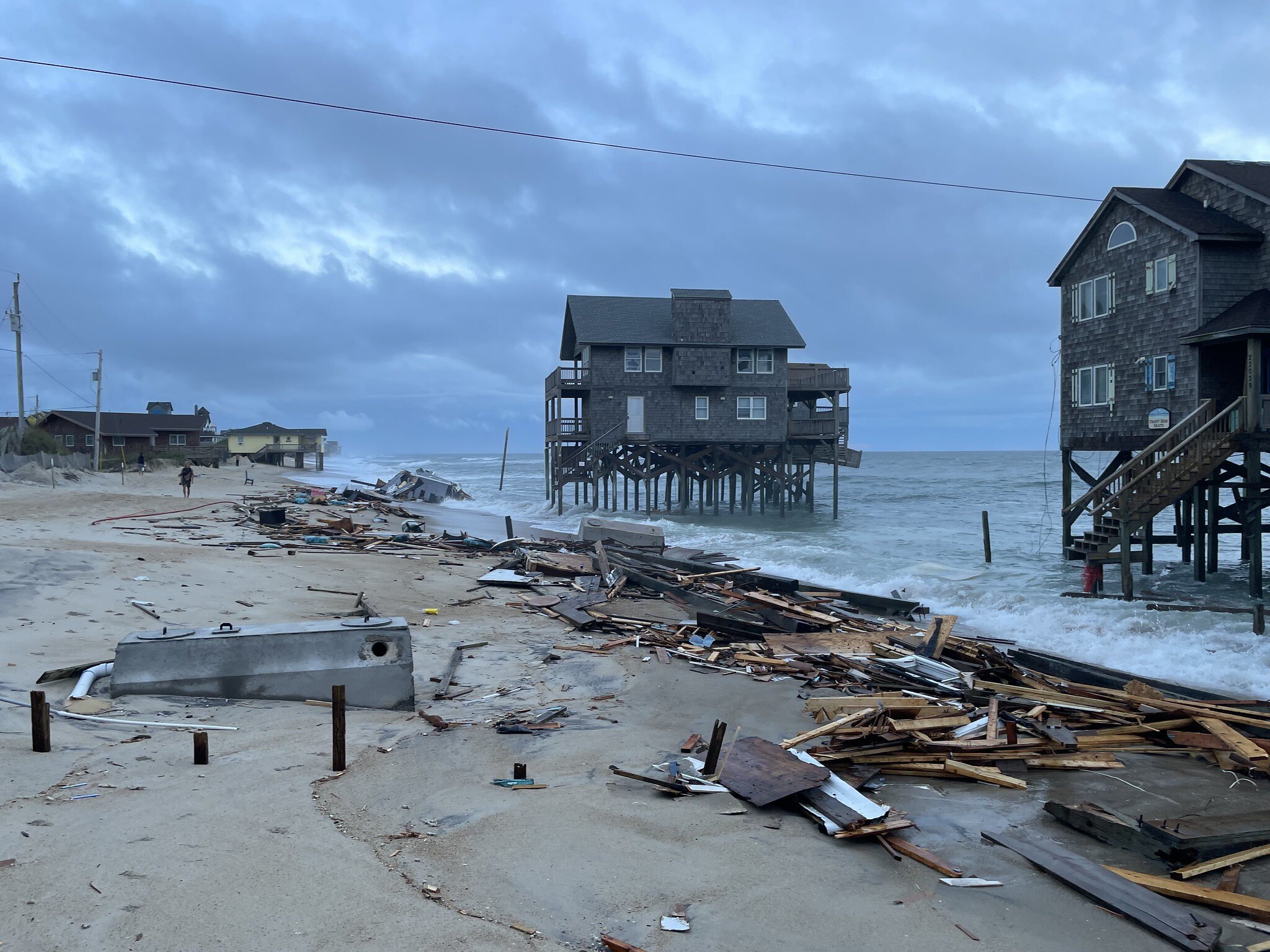
Two more houses have collapsed into the ocean in Rodanthe, North Carolina, following days of high surf and king tides impacting the narrow spit of sandy barrier islands in September. These losses mark the third and fourth homes taken by the tides in 2024, and the ninth since 2020. These two homes also represent the impacts of unmitigated climate change and unmanaged retreat in vulnerable, high-hazard coastal areas. This is what happens when there is a failure to take action to adapt or move away from risky areas where coastal erosion is compounded by rising seas, increasing flooding, and stronger, more frequent storms due to climate change.
While the properties were unoccupied, they pose a significant risk to human health and safety. Exposed wastewater infrastructure including septic systems pollute the ocean and nearby waterways and the collapsed structures create debris fields that endanger the safety of swimmers, surfers, and anyone who wants to recreate in the ocean north and south of Rodanthe. With every home that collapses, public health and safety are threatened and access to the treasured waves of the Outer Banks is limited due to the risks of physical harm from floating debris.
Meanwhile, the Cape Hatteras National Seashore and National Park Service are left to clean up the mess and foot the bill to remove what is left behind along the more than 70 miles of coastline under their care. While this cleanup is needed for ocean and public health, a chronically underfunded federal agency with notable staffing challenges and a $12 billion repair backlog should not be the inadvertent heir of coastal mismanagement issues in the Outer Banks. Despite decades upon decades of understanding that these barrier islands are prone to coastal erosion, Dare County and the state of North Carolina have failed to implement any meaningful program or funding mechanism to address coastal erosion and the threats to beaches and private property, despite compelling calls to action and research to support buyout in the region.
In May 2023, the Program for the Study of Developed Shorelines published a report evaluating the potential actions that Dare County could take in Rodanthe to address erosion and destruction of beaches and private property. The report clearly defined the options on the table for the barrier island: a) spend $120 million on beach nourishment over 15 years, an expensive investment with vanishing returns b) do nothing and allow for homes to collapse into the ocean, polluting the ocean and putting human and ecosystem health and safety at risk, or c) implement a buyout program for to relocate or remove highly exposed properties at a cost of $43 million to preserve a beach in Rodanthe for 15-25 years. Dare County has acknowledged that they simply do not have the funding to keep putting sand on the beach that will inevitably wash away, while doing nothing has done nothing but destroy the prized beaches and waves along Cape Hatteras National Seashore.
Dare County could take a page out of the National Park Service’s book and look to the retreat or removal of vulnerable properties out of harm’s way. Acknowledging the threats of erosion to one of the treasured cultural resources on the seashore, the Cape Hatteras Lighthouse, the National Park Service commissioned several studies on management options, which ultimately recommended relocation as the most fiscally responsible alternative. In 1999, the tallest lighthouse in North America was moved .3 miles from the shoreline to its current location at a cost of $11.4 million. While this decision took over a decade to put into action, it has preserved one of the most iconic structures along the Atlantic seaboard through managed retreat.
Unfortunately, Dare County and homeowners in Rodanthe do not have time on their side. With four homes taken by the sea in 2024 alone, countless structures at risk of imminent collapse, and compounding climate impacts growing, urgent action is needed to protect beaches in Rodanthe, including a plan to move out of harm’s way. Surfrider Foundation is empowering communities to lead adaptation efforts that focus on coastal resilience, relocation, and restoration in places like Surfers’ Point in Ventura, California and San Onofre State Beach in San Diego County. Our network is also harnessing the power of nature-based solutions to protect beaches and coastal ecosystems through our Climate Action Program, including Christmas tree dune plantings and dune restoration events up and down the North Carolina coast that bolster their resilience to erosion, flooding, and sea level rise. These programs and efforts represent the type of proactive, community-driven coastal management needed to protect our beaches from the growing impacts of climate change.
The residents of the Outer Banks do not have to sit idly and watch while properties fall prey to the next storm or tidal event. The option to buyout properties and relocate or remove them to protect and restore beaches in Rodanthe is still a viable option, but taking no action will all but ensure that the pristine coastal ecosystems of Cape Hatteras National Seashore, and all who enjoy it, are lost.
Learn more about Surfrider’s Coasts and Climate Initiative and efforts to protect our beaches and coastal ecosystems from the impacts of climate change here.
If you’re interested in joining the local charge to protect beaches in the Outer Banks, we are looking for volunteer leaders! Check out how you can get involved and learn more here.
Photo Credit: Cape Hatteras National Seashore
